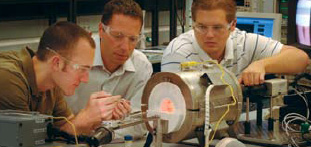

Ignition and Combustion of Bio Methyl Ester Fuel Droplets
Principal Investigator
Anthony J. Marchese, Ph.D.
Associate Professor
Department
of Mechanical Engineering
Colorado State University
Fort Collins, CO 80524
Email: marchese@colostate.edu
Telephone: (970)
491-2328
Project Summary
Biodiesel has been shown to be highly effective in reducing CO, HC, PM and greenhouse gas emissions from diesel engines, decreasing dependence on petroleum imports and developing new markets for domestic agricultural products such as soybeans. Unfortunately, most studies have also shown that biodiesel results in an increase in NOx emissions. The complete mechanism behind the NOx increase from biodiesel is not completely understood but evidence suggests that it is caused by differences in both the physical properties and the chemical oxidation mechanisms between biodiesel and petroleum diesel. To date, the contribution to the biodiesel NOx increases related to differences in chemical kinetics has received very little attention. Similarly, the chemical kinetic mechanism responsible for the dramatic decreases in PM emissions from biodiesel is also poorly understood. As a first step in understanding the chemical kinetic mechanisms behind biodiesel NOx and PM processes, appropriate surrogate fuels must be identified that have similar chemical structure (and/or autoignition characteristics) to the long chain methyl esters found in biodiesel.
In this research, droplet ignition delay experiments are conducted using a variety of methyl esters and the results are compared to commercial soy methyl ester biodiesel. Specifically, fuel droplets were injected into a tube furnace containing atmospheric air at temperatures up to 1000 C. The ignition event is characterized by measurement of UV emission from hydroxyl radical (OH*) chemiluminescence. n addition to the biodiesel surrogate fuels, experiments are conducted using methanol, for which a validated, detailed kinetic mechanism exists. The experimental results for methanol are compared against a detailed, time-dependent numerical model. Droplet ignition experiments are chosen as a means to evaluate liquid biodiesel surrogate fuels because spherically symmetric droplet combustion represents the simplest two-phase, time-dependent chemically reacting flow system that can be solved numerically with detailed chemical kinetics and transport. To obtain spherical symmetry, experiments are conducted using a 1.1-second drop tower.
Publications
Project Personnel
Anthony Marchese, PI
Matt Hammill, '03,'05, Rowan University
Tim Vaughn, '05,'06, Rowan University
Mark Wessel, '06, '07, Rowan University
Michael Harris, '06, Tennessee Tech
Last Updated: August 1, 2006